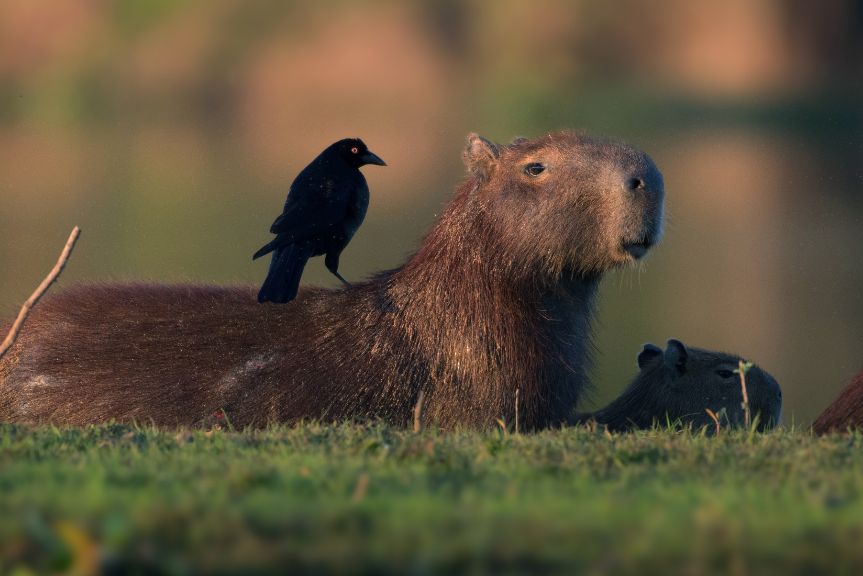The capybara, the largest rodent in the world, is a fascinating creature that has captivated people around the world for centuries. This species, known for its playful demeanor as well as its social nature, is beloved by both pet owners and wildlife enthusiasts. The key question that arises frequently is: how long are capybaras alive? Diet, environment, social needs, and healthcare are all factors that influence the lifespan of these remarkable creatures, which is examined in detail in this article.
How Long Can Capybaras Live?
In the wild, capybaras typically live for 8 to 12 years, though some individuals may live longer under ideal circumstances. Capybaras can live for up to 14 years in captivity, where they are protected from predators and given consistent food and healthcare. In order to properly care for them, one needs to understand the significant differences between their wild and captive life expectancies.
Wild Capybaras vs. Captive Capybaras
It is common for capybaras to face a wide array of challenges while in the wild, including predation, environmental stress, and limited food access. These factors often contribute to a shorter lifespan than those in human care. The capybara, on the other hand, that lives in captivity, has consistent access to nutrition, and receives veterinary care, which significantly extends its life expectancy, whereas wild capybaras are not protected from predators.
How Much Do Capybaras Weigh?
The size of a capybara can vary depending on factors such as gender and age, with males generally being larger than females. Males can weigh anywhere from 77 to 146 pounds (35 to 66 kg). The adult capybara can grow to be about 4.3 to 4.6 feet (1.3 to 1.4 meters) long and about 2 feet (0.6 meters) tall. In order to navigate water efficiently, their robust bodies are designed for swimming, with webbed feet and streamlined shapes. Despite their size, capybaras are gentle and social animals.
Essential Factors That Affect Capybara Lifespan
Several factors affect a capybara’s lifespan, including genetics, diet, environment, social structure, and healthcare.
1. Genetics: The Role of Inheritance
Biological factors play a significant role in determining how long a capybara lives. Like other species, capybaras are sensitive to certain health issues based on their genetics. However, a capybara with strong genetics, especially one bred from healthy lines, is likely to survive and thrive. It is for this reason that breeding practices that emphasize genetic health can extend the life spans of capybaras, whether they are wild or pet animals.
2. Diet: Nourishment for Lifespan
A balanced diet is one of the most important factors in ensuring a capybara’s long and healthy life. These animals eat mainly grasses, aquatic plants, and fruits in the wild. They have a naturally high fiber diet and low sugar diet, which is essential for maintaining good health.
In captivity, it’s important to replicate this diet as closely as possible. Fresh grasses and hay should form the majority of their diet, while vegetables can offer additional nutrients. Overeating fruit can significantly affect their health and lifespan. Providing ample fresh water for hydration is also important for capybaras, as they enjoy spending time in the water, which keeps them hydrated and cool.
3. Social Needs: Companionship for a Longer Life
In the wild, capybaras live in large groups and create strong social bonds. Their well-being depends heavily on their ability to interact with others. The health and longevity of capybaras can be negatively affected if they do not receive enough social interaction, which can lead to stress, depression, and anxiety.
If you keep capybaras as pets, you need to make sure they have companionship, whether that means keeping more than one capybara together or ensuring they can interact with other animals. Both mental and physical health can decline quickly in a solitary capybara when it becomes lonely and unhappy.
4. Environment: A Safe and Comfortable Habitat
Capybaras’ living environment is crucial to their health and well-being, whether they are living in the wild or in captivity. They naturally gravitate to wetlands with water access, where they can swim and forage.

As capybaras spend a significant period of their lives in the water, it is vital that they are kept in a secure and spacious environment when they are in captivity. Because capybaras are excellent swimmers, they need access to water for swimming. Providing a comfortable, temperature-controlled environment also prevents capybaras from experiencing extreme heat or cold, both of which can result in stress and health complications.
5. Veterinary Care: Preventative Measures
Maintaining a capybara’s health requires regular veterinary visits. If left untreated, dental problems, respiratory infections, or parasites can shorten their lives. Regular checkups can help catch potential health issues early. It is essential to protect capybaras against parasites and vaccinations throughout their lives through a proactive approach to healthcare.
Capybaras in the wild often lack access to veterinary care, making them more vulnerable to injury and illness. The animals in captivity can live a long and healthy life by getting regular veterinary visits.
Common Health Issues That Affect Capybara Longevity
It is important to note that capybaras are generally hardy animals, but they are susceptible to certain health problems that affect their well-being and longevity.
1. Dental Issues
As capybaras grow, their teeth continue to grow, and if they don’t wear down from chewing tough vegetation, they can become overgrown. This can result in pain, difficulty eating, and infections. Providing the right diet and regular dental checkups can help prevent these problems from developing.
2. Obesity
Overfeeding capybaras with sugary fruits and processed foods is a common cause of obesity in captive capybaras. A capybara’s life can be shortened and its quality of life reduced if they are obese, due to joint pain, heart disease, and diabetes. For a healthy weight to be maintained, it is essential to exercise regularly and eat a balanced diet.
3. Respiratory infections
Respiratory infections are common among capybaras kept in damp or poorly ventilated environments. If not treated promptly, these infections can become severe and even fatal. Preventing respiratory illnesses requires providing a clean, dry environment with adequate air flow.
4. Parasites
A capybara is susceptible to a wide range of parasites, including ticks, mites, and intestinal worms, especially in the wild. In captivity, regular deworming and parasite control are required to prevent infestations.
How to Care for Capybaras for a Long Life?
If you are lucky enough to care for a capybara, there are several practical steps you can take to ensure it enjoys a long and healthy life:
- Provide a proper diet: Focus on fresh grass, hay, and vegetables. Limit sugary treats to maintain a healthy weight.
- Ensure social interaction: Capybaras love company. Keep them in pairs or small groups to mimic their natural social structure.
- Create an appropriate environment: Offer a spacious enclosure with access to water for swimming. Ensure the habitat is secure and temperature-controlled.
- Regular veterinary visits: Schedule regular health checkups and follow your vet’s recommendations for vaccinations, parasite control, and overall care.
- Monitor health issues: Keep an eye on your capybara’s weight, teeth, and general health. If you have any concerns, contact your vet to prevent complications.
Conclusion
With proper care, capybaras often live longer, more fulfilling lives than in captivity. A balanced diet, social interaction, a suitable environment, and regular veterinary care are all key factors in ensuring these amazing animals thrive. You can help your capybara live to its fullest potential by understanding the factors that influence their health.
